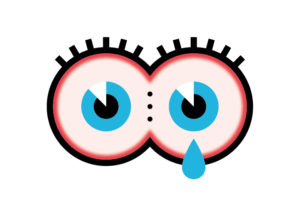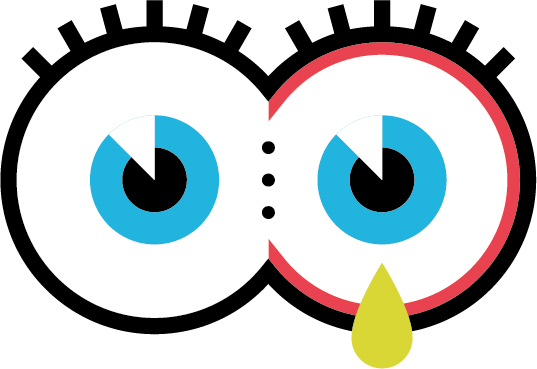 Learn more about eye diseases
Learn more about eye diseases
Conjunctivitis
What is conjunctivitis?
This eye infection is an inflammatory condition of the conjunctiva, a transparent membrane that covers the eye and the inner surface of the eyelids.
In 95% of cases, the three most common causes of conjunctivitis are viral infections followed by bacterial infections and allergies.
What are signs of conjunctivitis in children?
Does your child have red and watering eyes? Do their eyes and eyelids itch? When they wake up, are there yellowish secretions on the eyelashes? They certainly have conjunctivitis.
There are three types of conjunctivitis and different associated symptoms:
Viral conjunctivits

Viral conjunctivitis: bilateral and clear lacrimation
Very common, especially in children, it is due to various viruses. Viral conjunctivitis often affects both eyes at the same time, it is accompanied by clear and colourless eye secretions. Symptoms last an average of 5-7 days. Conjunctivitis is extremely contagious because eye secretions contain a multitude of microbes.
Bacterial conjunctivitis

Bacterial conjunctivitis: purulent exudate
Very common, especially in children, it is due to various viruses. Viral conjunctivitis often affects both eyes at the same time, it is accompanied by clear and colourless eye secretions. Symptoms last an average of 5-7 days. Conjunctivitis is extremely contagious because eye secretions contain a multitude of microbes.
Allergic conjunctivitis
Often associated with allergic rhinitis, allergic conjunctivitis occurs in the spring. The most common allergens are grass, herbaceous or tree pollens. The itching sensation is severe and the child cannot help but rub their eyes. In some cases, conjunctivitis is accompanied by other signs that may affect one or both eyes.
How can conjunctivitis be prevented?
We recommend simple hygiene measures to avoid contracting your child’s conjunctivitis:
- It is first important to avoid contact with someone with infectious conjunctivitis.
- It is also advisable to wash your hands after sneezing or blowing your nose, and before putting on or removing contact lenses.
How can conjunctivitis be treated?
The majority of cases of conjunctivitis, regardless of their cause, disappear naturally after two weeks. Depending on the severity, several suitable treatments may be necessary to relieve symptoms. Treatment of conjunctivitis is based on the administration of eye drops, the composition of which varies according to the cause of the conjunctivitis:
- Viral conjunctivitis is treated with cold water compresses. Your paediatrician will prescribe lubricating and/or antiseptic eye drops to avoid bacterial superinfections.
- Bacterial conjunctivitis is treated with antibiotic and/or anti-inflammatory eye drops.
- Allergic conjunctivitis is treated with antiallergic eye drops and/or antihistamine drugs to be taken by mouth.
During treatment and until complete recovery, the wearing of contact lenses is not recommended. We advise you to consult a doctor or your ophthalmologist for advice on treating your child’s conjunctivitis.
Find out more about children's visual disorders
Do you want to learn more about a particular visual condition? Discover our pages on eye allergy, congenital glaucoma, hyperopia, strabismus, and dry eye. We explain these visual disorders and tell you how to treat them to preserve your children’s visual acuity.
